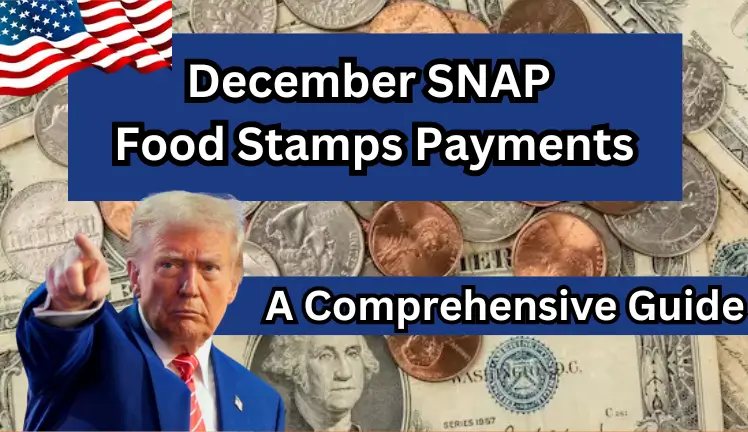December SNAP Food Stamps Payments: As the holiday season approaches, many households relying on SNAP (Supplemental Nutrition Assistance Program) benefits start planning their monthly budgets carefully. December, with its extra expenses and seasonal challenges, calls for special attention to the timing and management of SNAP food stamps payments. This guide provides an in-depth look at how December SNAP payments work, what factors influence the schedule, and tips for making the most of your benefits.

Understanding the SNAP Program
SNAP, commonly known as food stamps, is a federal assistance program that helps eligible low-income households purchase nutritious food. Benefits are provided through an Electronic Benefits Transfer (EBT) card, which functions similarly to a debit card.
- Purpose: To ensure food security and support a balanced diet for millions of Americans.
- Distribution: Benefits are issued monthly, and the schedule varies by state.
December Payment Cycle Explained
What to Expect in December
December is a critical month for SNAP recipients due to increased household expenses during the holiday season. While most states distribute benefits monthly, the exact dates can vary widely. Some states release benefits across a range of dates, while others have fixed schedules.
- Staggered Issuance: Many states issue SNAP benefits over several days in December to prevent system overload and ensure a steady supply of food at local retailers.
- Special Categories: Certain groups, such as elderly or disabled recipients, may receive their benefits earlier in the month.
The Role of EBT
The EBT system is central to SNAP payments. Each month, your benefit amount is automatically loaded onto your EBT card, which you can use at participating retailers. This digital process helps ensure that funds are deposited securely and on time.
Factors Affecting Payment Dates
Several elements can influence when you receive your SNAP benefits in December:
State-Specific Schedules
- Local Administration: Each state administers its own SNAP program. The payment schedule may be determined by factors like case numbers, Social Security numbers, or even birthdays.
- Fixed vs. Staggered Dates: Some states opt for a fixed payment date for all recipients, while others distribute payments over several days.
Administrative and Holiday Considerations
- System Upgrades: Occasionally, states update their EBT systems, which may cause slight shifts in the usual payment schedule.
- Holiday Staffing: With December being a busy month for government offices, minor delays can occur due to reduced staffing or administrative backlogs.
Preparing for December Payments
Proper preparation can help you manage your monthly budget more effectively during December.
Budgeting Strategies
- Plan Ahead: Review your monthly budget and account for the extra holiday spending. Identify essential expenses such as groceries, utilities, and any seasonal costs.
- Save a Portion: If possible, set aside a small portion of each SNAP payment in an emergency fund to cover any potential delays or unexpected expenses.
Monitoring Your EBT Card
- Regular Checks: Use your state’s online portal or mobile app to monitor your EBT balance and payment status.
- Notifications: Many systems allow you to set up alerts for when your payment is deposited, ensuring you are immediately aware of any changes.
What to Do If Your Payment Is Delayed
Despite careful planning, delays can occur. Here are some steps to take if you do not receive your December SNAP benefits on time:
Contact Customer Support
- Immediate Inquiry: Reach out to your local SNAP office or customer service hotline as soon as you notice a delay.
- Keep Records: Document the date of your expected payment and any communications with customer support for follow-up.
Explore Additional Assistance
- Local Resources: Consider visiting local food banks, community kitchens, or other emergency assistance programs if you face a short-term shortage.
- Stay Informed: Regularly check your state’s official SNAP website for updates on payment schedules or any temporary changes.
Tips to Maximize Your SNAP Benefits
To make the most of your SNAP benefits during December and beyond, consider the following strategies:
- Create a Detailed Budget: Track all your essential expenses and plan your grocery shopping to avoid overspending.
- Utilize Technology: Set calendar reminders for your payment dates and use mobile apps to check your EBT balance frequently.
- Plan Your Grocery Trips: Shop on or immediately after your SNAP payment date to ensure the best selection and avoid last-minute rushes.
- Educate Yourself on Policy Changes: Stay updated with any changes in SNAP policies or payment schedules by subscribing to alerts from your state’s social services website.
FAQs on December SNAP Food Stamps Payments
1. When are SNAP payments usually issued in December?
Payment dates vary by state. Many states stagger benefits between the 1st and the 23rd of December. Check your state’s official schedule for specific dates.
2. What should I do if my SNAP payment is delayed?
Contact your local SNAP office or customer service immediately. Monitor your EBT balance online and document any issues for further follow-up.
3. Are there special payment dates for elderly or disabled recipients?
Yes, in many states, elderly or disabled recipients receive their benefits earlier in the month—typically between the 1st and 4th of December.
4. How can I prevent issues with my EBT card?
Regularly monitor your balance, use available security features like locking your card via a mobile app, and report any suspicious activity immediately.
5. What other resources are available if my payment is delayed?
Local food banks, community kitchens, and emergency assistance programs can provide additional support during short-term delays.
Conclusion
December brings its own set of challenges and opportunities for SNAP recipients. Understanding the payment cycle, monitoring your EBT card, and planning ahead can help you manage your monthly budget more effectively during the holiday season. By staying informed and taking proactive steps, you can ensure that your household remains food secure even if minor delays occur. Remember, if you encounter any issues, there are resources available to help you navigate these challenges.
Admin at Sirfal.com – Experienced blogger since 2015, sharing Q&A content and latest job updates.